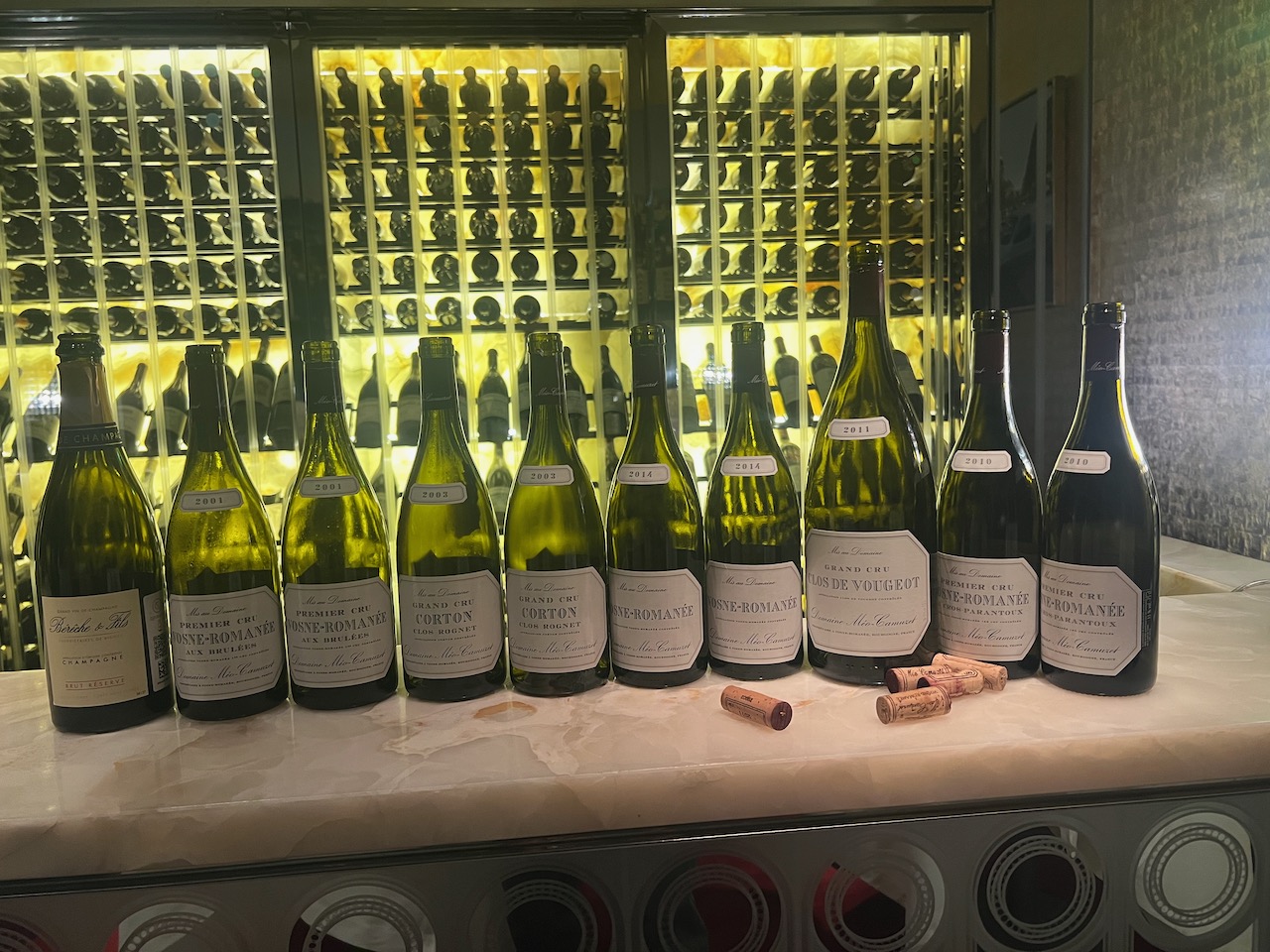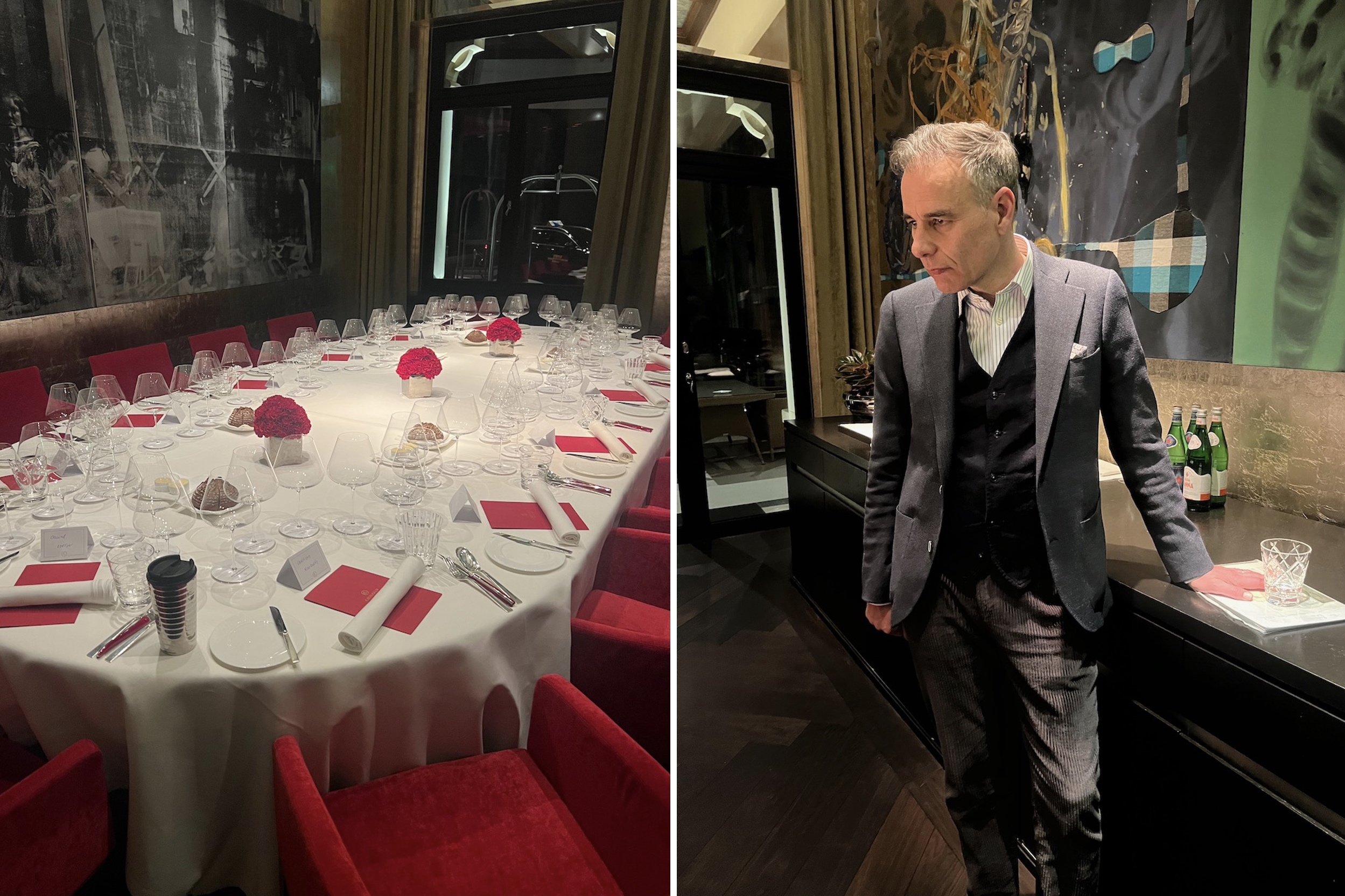Crurated is a new kid on the block when it comes to wine merchants, but not just any new kid, a very noteworthy one. They have a very different approach that fills an important market gap. They focus on highly sought after, collectible wines that you usually only get from merchants when you have been a customer for a long time. What they do instead is to offer these wines bottle by bottle instead of cases by cases. You may only get one or two bottles of your favorite Crus but when it comes to Burgundy that is better than not getting any or having to buy them on the secondary market for a much higher price. Hence, for those who want to round their collection with additional gels, Crurated is really a name to look out for (www.crurated.com). Throughout the year they also organize tastings with wine merchants across Europe and I have recently attended their three day event in Beaune and so I was looking forward to their Meo Camuzet dinner, organized by their European Sales director Gregoire Binotti, at the Dolder Grand in Zurich. Jean-Nicolas Méo led through the evening in his placid, analytical style, reflecting on vintages and vineyards. We learned a lot, also about his selective taste on white wines, that other than white Burg, includes German Riesling. I am certainly on the same page with him on this.
Domaine Méo-Camuzet is one of the top names in Burgundy today, known for its rich, polished, and age-worthy wines, especially from Vosne-Romanée. But for much of its history, the domaine didn’t even make its own wines—many of its vineyards were leased out under métayage agreements. That changed in the late 1980s when Jean-Nicolas Méo took over and began bottling under the estate’s name. His biggest influence? Henri Jayer, the legendary Vosne-Romanée winemaker, who mentored Jean-Nicolas and shaped the domaine’s style. Today, Méo-Camuzet is firmly established as one of the leading estates in the Côte d’Or.
Jayer had been farming some of Méo-Camuzet’s top vineyards for decades, and when the leases ended, he guided and trained Jean-Nicolas as he transitioned into running the domaine himself. Jayer’s influence was profound, particularly in winemaking techniques, including:
- Destemming: Jayer was famous for always destemming his grapes, Méo-Camuzet continues this approach as a principle, but will step away from it ocasionally when he feels adding some stems can improve acuvée, eg, adding some freshness or reducing alc level.
- New oak usage: Méo continues a traditional oak re regime, that varies depending on the wine’s classification. Grand Cru, up to 100%, Premier Cru 60-70% and village / Bourgogne <50%). Generally, they employ a moderate approach with lighter toast barrels.
- Precision and elegance: Jayer’s philosophy of making wines that were both concentrated and elegant left a lasting impact.
The domaine has some prime vineyard holdings. Its lineup includes heavy hitters like Richebourg Grand Cru and, of course, the famous Cros Parantoux 1er Cru, a tiny but highly prized vineyard that Jayer himself helped put on the map. Meo and Emmanuel Rouget are the only two producers with holdings of this plot. There’s also a strong selection of Vosne-Romanée and Nuits-Saint-Georges premier crus, such as Les Brûlées and Les Boudots, plus a Corton Perriere and a Corton Rognet Grand Cru from the hill of Corton. There are also a series of wines under their negoce label (purchased fruit) Méo-Camuzet Frère & Soeurs, ranging from Village to Grand Cru. I personally like the Chambolle-Musigny 1er Cru Les Cras and Les Feusselottes from that portfolio.
Méo-Camuzet’s domaine wines are known for their darker pitched, deep aromatics and notable structure, combining generous fruit and well-integrated tannins and oak. Unlike some other Vosne-Romanée producers, the domaine de-stems its grapes, leading to a concentrated style rather than a whole-cluster profile. These wines are built for the long haul – often needing 10-20 years to fully hit their stride – but they’re always full of personality and precision.
Given the combination of exceptional terroir and Jayer-inspired winemaking, it’s no surprise that Méo-Camuzet’s wines are highly sought-after. Prices reflect that, especially for the flagship bottlings, which are snapped up quickly by collectors. Critics like Jasper Morris, William Kelley, and Neal Martin consistently praise the wines, with Kelley describing them as “sumptuous and aromatically refined.” Clive Coates once called them “modern Burgundy at its very best.”

Tasting Notes
2014 Vosne-Romanée, 91 Points
Sourced from two plots—one higher up the slope, bringing freshness, and another lower down, adding weight. This year, the cooler site dominates, as Jean-Nicolas Méo observed. The nose is dark and brooding, with earthy tones and black cherry. Tannins show a touch of dryness, and the wine took time to open. Decanting recommended.
2011 Clos de Vougeot Grand Cru, 94 Points
From Magnum. A strikingly expressive nose, full of cool blue fruit, subtle smoky notes, and well-integrated oak. The palate is refined, structured yet composed, with an aristocratic poise. Drinking well now, especially with aeration, but will hold.
2003 Corton Rognet Grand Cru, 95 Points
A fascinating take on the heatwave vintage. Surprisingly lifted, with an explosive red-fruited nose and a distinctive menthol freshness. Ripe, yet avoiding over-maturity, with vibrant raspberry and spice on the finish. A real success in 2003.
2010 Vosne-Romanée 1er Cru Cros Parantoux, 95+ Points
Darker-fruited and more restrained than the 2003 Corton tasted alongside. The nose remains discreet, but the structure is impeccable – licorice, earthy spice, and finely poised tannins. Complex but still tightly wound. If you are lucky enough to have this in your cellar, give it a few more years to fully mature.
2001 Vosne-Romanée 1er Cru Les Brûlées, 96 Points
Beautifully mature, with an intricate nose of farmyard, spice, and sous-bois. The palate is layered and generous, lifted by the bright acidity of the vintage. Grand Cru-level complexity. My wine of the night.
Author: Christian Raubach, WSET III, FWS, WSG Champagne Master
March 2025

